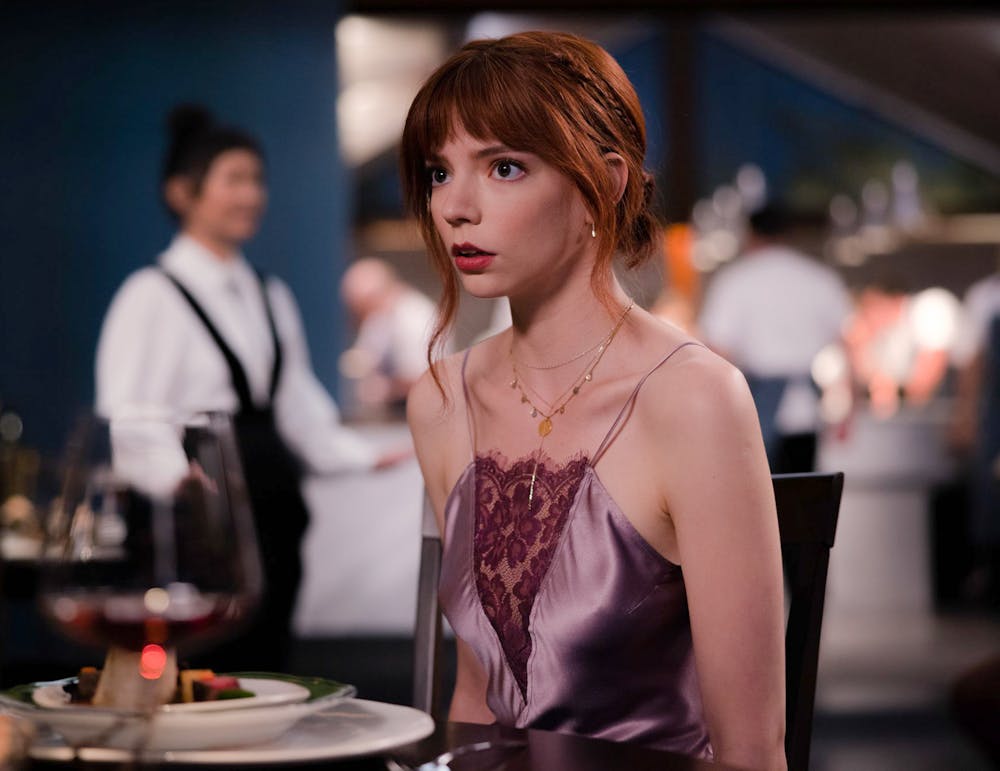“The Menu” is a film obsessed with class. From its first to final scenes, the movie covers one of the most exclusive and extravagant dinners ever made with some of America’s wealthiest citizens in attendance. At first, the film appears to largely focus on aesthetics, focusing on the food, the restaurant and the private island where the dinner takes place. But as the movie progresses and more is revealed about the night’s once-in-a-lifetime menu, horror sets in. The chef, as well as the guests, make a series of disturbing decisions, and satire of the darkest kind soon becomes the film’s main goal.
The film follows the outline of a multi-course meal served at Chef Julian Slowik’s (Ralph Fiennes) Michelin-star-worthy restaurant Hawthorn. The film’s central protagonist is Margot Mills (Anya Taylor-Joy), a paid escort who has been hired by Tyler (Nicholas Hoult) to attend this lavish meal. Since Hawthorn can only be reached by water, the film begins with Margot and Tyler stepping aboard a boat. But “The Menu” soon expands to chart the stories of the rest of the guests, all of whom have one thing in common: They are some of the most grossly wealthy people America has to offer.
When first stepping into Hawthorn, Margot picks up on an acute class divide. The guests are all entitled, absurdly self-obsessed and either rich or famous. The workers are dressed identically, speaking only when spoken to and all participating in vaguely cult-like behavior. Margot doesn't quite fit into either category, which is perhaps why she is the first guest to sense when the meal has gone wrong.
About halfway into the dinner, it is revealed that every guest except Margot has been invited for a very specific purpose that night: Slowik plans for them all to die. To him, the guests — people who live lavishly without ever stopping to appreciate life’s genuine moments — represent everything that is wrong with his craft and the food industry. With their constant consumption and failure to ever give back, they have sucked almost all of the passion out of his work. Along with taking the lives of his guests, Slowik intends to kill the restaurant's entire staff, himself included.
Inevitably, the news of their imminent deaths causes panic among Hawthorn’s guests. Most attempts to escape prove comical and futile as Margot seems to be the only guest who possesses any sort of resourcefulness. Everyone else’s comparable helplessness underscores the vanity of their social positions. Their money — no matter the amount — will not be able to save them.
Despite its gruesome premise, “The Menu” is actually a very funny film. The dialogue is quick and clever, with characters often saying things so disturbing that viewers are left with no choice but to laugh aloud. During dinner, the camera pans successively to each table, featuring one absurd party after the next. There is a movie star dating a woman a quarter of his age, followed by a trio of young business giants who have more money than they know what to do with. One food critic is so pretentious it makes a viewer want to throw her out a window, and then there is Tyler, whose devotion to Slowik is equally cringeworthy.
Part of the reason the film’s writing seems so clever is its delivery. From the chef to the guests (including characters played by Janet McTeer and Judith Light) to Hawthorn’s unforgettable hostess (Hong Chau), “The Menu” features an absolutely star-studded cast. Everybody is somebody, even if it might take a second to deduce where the viewer knows them from. Fiennes is perfect per usual, and Taylor-Joy delivers a genuinely successful performance. Chau is able to make her character into one of the funniest of the entire cast, and Hoult, despite his boyish affect, somehow comes across as one of the most disturbed. Though the big voices of an ensemble cast can often crowd each other out, they instead complement each other in “The Menu,” thus working in the film’s favor.
There is no question that “The Menu” is meant to satirize the lives of people from the upper echelon of society. Yet there is no denying how the film feeds into our own fascination with the elite. We may laugh at the utter absurdity of such first-world problems, but this doesn’t stop us from intently watching how each guest eats, acts and speaks. Even Margot, who is technically working while on her “date,” is able to dress and act the part. The aesthetics of the film additionally help bolster the intrigue of the upper class rather than bring it down. The restaurant is gorgeous, the island pristine and the meal a work of art (even if it may not look like something you’re meant to eat). Scenes gain their beauty precisely because they are focused on such extravagant images. There is, in this sense, an inevitable irony to “The Menu’s” main mission: The film might actually be obsessing over the very people it is trying to condemn.

Rya is an Arts & Culture editor from Albany, NY. She is a senior studying English and Literary Arts, and her favorite TV show is Breaking Bad.





